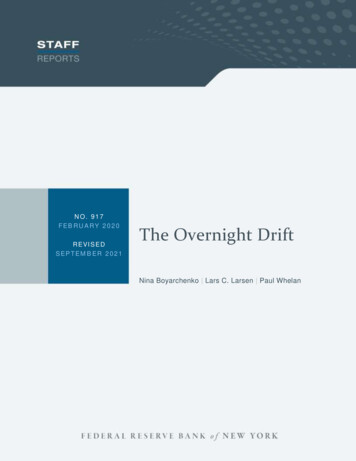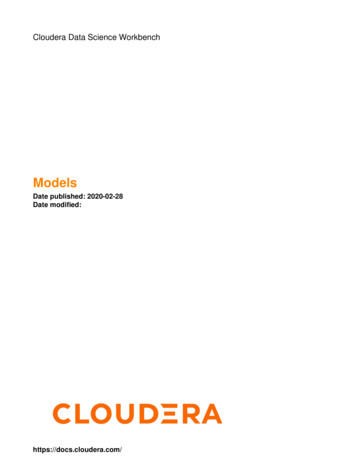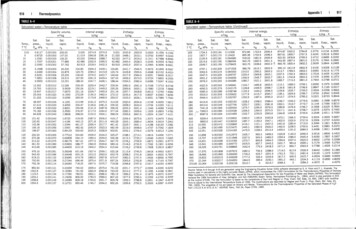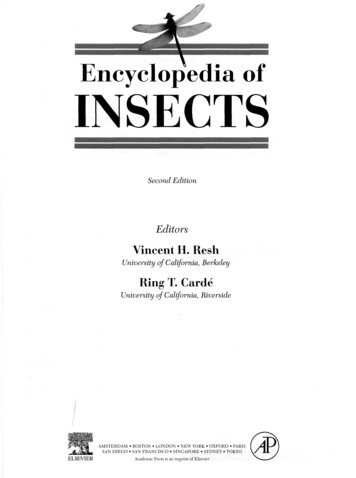
Transcription
NO. 917FEBRUARY 2020REVISEDSEPTEMBER 2021The Overnight DriftNina Boyarchenko Lars C. Larsen Paul Whelan
The Overnight DriftNina Boyarchenko, Lars C. Larsen, and Paul WhelanFederal Reserve Bank of New York Staff Reports, no. 917February 2020; revised September 2021JEL classification: G13, G14, G15AbstractThis paper documents large positive returns to holding U.S. equity futures overnight during the openinghours of European markets. Consistent with models of inventory risk and demand for immediacy, wedemonstrate a strong relationship with order imbalances arising at the close of trade from the previousU.S intraday session. Rationalizing unconditionally positive “overnight drift” returns, we uncover astrong asymmetric reaction to demand shocks: market sell-offs generate robust positive overnightreversals while reversals following market rallies are much more modest. We argue that this demandshock asymmetry is consistent with time-variation in dealer risk bearing capacity.Key words: overnight returns, immediacy, volatility risk, inventory riskBoyarchenko: Federal Reserve Bank of New York (email: nina.boyarchenko@ny.frb.org). Larsen,Whelan: Copenhagen Business School (emails: lcl.fi@cbs.dk, pawh.fi@cbs.dk). The authors thankTorben Andersen, Vincent Bogousslavsky, Andrea Buraschi, Jens Dick-Nielsen, Darrell Duffie, BjørnEraker, Michael Fleming, Mathieu Fournier, Thomas Geelen, Ravi Jagannathan, David Lando, DongLou, Charles Martineau, Alex Michaelides, Philippe Mueller, Lasse Pedersen, Fabrice Tourre, AndersTrolle, Gyuri Venter, Andrea Vedolin, and audiences at various conferences and seminars for theircomments and suggestions. Paul Whelan gratefully acknowledges financial support from the DanishCouncil for Independent Research (grant no. 9037-00105B) and the Danish Finance Institute (DFI). LarsC. Larsen gratefully acknowledge financial support from the Center for Financial Frictions (FRIC), grantno. DNRF102.This paper presents preliminary findings and is being distributed to economists and other interestedreaders solely to stimulate discussion and elicit comments. The views expressed in this paper are those ofthe author(s) and do not necessarily reflect the position of the Federal Reserve Bank of New York, theFederal Reserve Bank of Philadelphia, or the Federal Reserve System. Any errors or omissions are theresponsibility of the author(s).To view the authors’ disclosure statements, visithttps://www.newyorkfed.org/research/staff reports/sr917.html.
Since the advent of electronic trading in the late 1990’s, U.S. S&P 500 index futures have tradedclose to 24 hours a day. In this paper we document that, despite the 24 hour nature of the market,returns do not accrue linearly around the clock. In fact, the largest positive returns are between2:00 a.m. and 3:00 a.m., the opening of European markets in U.S. Eastern Time terms, averaging3.6% on an annualized basis. Focusing on returns during this hour, we show that positive averagereturns are highly statistically significant, consistently present throughout the 1998 – 2020 sample,accompanied by substantial trading volume, and do not cluster on any particular day of the weekor month of the year. We dub this positive average return the ‘overnight drift’, and argue thatthis pattern of returns is driven by overnight resolution of order imbalances from the end of thepreceding U.S. trading day. Consistent with predictions of models of immediacy, we documentthat the overnight drift is larger following days with larger end-of-day sell order imbalances andeven more so when occurring during periods of heightened uncertainty.Models of immediacy, such as Grossman and Miller (1988), show that risk-averse market makersprofit by providing liquidity to investors who arrive asynchronously to the market, generatingmean reversion in prices as market makers absorb shocks to their inventories.1 To understand howinventory management concerns can lead to the overnight drift, suppose there is selling pressureduring the day, translating into an overall negative order imbalance by the end of regular tradinghours. Market makers become net buyers, bearing inventory risk until they are able to sell to newmarket participants arriving overnight; however, they demand compensation for this in terms ofpositive expected returns. In other words, they must expect to be able to sell this inventory at ahigher price than at which they acquired it. As new participants arrive overnight, market makersoffload their inventory and prices gradually rise.We conduct a number of tests to document that the relationship between the overnight driftand trading imbalances is as predicted by Grossman and Miller-style models. First, sorting daysbased on end-of-trading-day order imbalance, we show that positive overnight returns occur onlyon nights following market sell-offs (negative end-of-day order imbalances). When end-of-day sellorder imbalances are large (more than 10,000 contracts), contemporaneous closing returns are, onaverage, -94.7% p.a. The subsequent overnight returns average 8.95% p.a. during Asian hours1The CME does not designate ‘specialist’ market makers in e-mini futures. Instead, effective market makers are anyparticipant willing to post limit orders on both sides of the order book and hence supplying liquidity (immediacy) to markettakers.1
and 14.5% p.a. during the EU open, of which 10.78% p.a. accrues around the opening of Europeanmarkets between 2:00 a.m - 3:00 a.m ET alone. Price reversals following market rallies are muchmore modest: When buy order imbalances are above 10,000 contracts, contemporaneous closingreturns are on average 87.98% p.a. but the subsequent overnight returns average 8.84% p.a.during Asian hours, 0.4% p.a. during European hours, and there is no reversal effect between 2:00a.m - 3:00 a.m ET. Thus, although market sell-offs and market rallies at U.S. close are similar inmagnitude (though, naturally, of opposite sign), positive closing order imbalances lead to muchsmaller price reversals than negative closing imbalances, generating an unconditional positiveovernight drift. We confirm the asymmetry of price reversals following positive and negative end-ofday order imbalance days more formally by estimating high frequency predictability regressions ofreturns on end-of-day order imbalance, and find statistically and economically significant loadingson the hours when London and Frankfurt financial markets open. Thus, high frequency returnsbecome predictable as market makers transact with new participants arriving overnight, tradingaway order imbalances remaining from the previous U.S. trading day.Second, we document that price reversals following negative closing order imbalance days arelarger if order imbalances occur on days with increased uncertainty. In double sorts on end-of-dayorder imbalance and the end-of-day level of VIX, we show that, conditional on the level of theVIX, average overnight returns are higher following days with greater negative end-of-day orderimbalance. Conversely, conditional on the size of negative end-of-day order imbalance, averageovernight returns are higher following days with greater end-of-day levels of the VIX. That is,consistent with the predictions of models of immediacy, price reversals are larger following dayswith larger end-of-day order imbalances and even more so if the large order imbalances coincidewith periods of heightened uncertainty. Moreover, the double sorts on end-of-day order imbalancesand end-of-day level of the VIX reveal that the distribution of the VIX is similar across positiveand negative order imbalance days, suggesting that the asymmetry in price reversals followingnegative and positive end-of-day order imbalances is unlikely driven by a correlation betweenorder imbalances and the level of asset return variance. Instead, we speculate that this asymmetryis related to time-varying risk-bearing capacity of the market makers in this market, with largemarket sell-offs potentially leading to fewer active market makers in the market.Third, we conduct a natural experiment to test the relationship between the overnight price2
reversal and the arrival of overnight traders. In particular, we exploit the fact that while theU.S. observes daylight savings time (DST), Japan does not, so that, as seen from the perspectiveof a U.S. trader, the timing of Japanese market opening changes exogenously from 7 p.m. inwinter to 8 p.m. in summer.2 Indeed, accounting for DST, return predictability around Tokyoopen shifts forward by one hour when moving from winter to summer time, so that exogenousvariation in the time of arrival of liquidity traders leads to predictable variation in the returnsearned overnight. Expanding the natural experiment to also include the 3 weeks of the year whenthe DST is asynchronous between the U.S. and Europe, we again find that the overnight returnpredictability shifts to the 4-5 a.m. hour (the first hour of regular trading in London and Frankfurtwhen the U.S. - Europe time difference is 4 hours) though the point estimate is not significant dueto the low number of observations.A natural question is why do price reversals not happen immediately upon overnight marketopening but instead take time to resolve. The answer is that, even though overnight volumeshave grown steadily over our sample period, the close of regular trading at 16:15 EST marks theonly time of the day when volumes jump discontinuously down. Even in recent years volumesduring Asian open hours remain substantially below volumes at the U.S. close: between 2009- 2020 trading volumes in regular Asian hours (18:00 - 2:00 a.m.) were 50 to 100 times lowerthan volumes during U.S. trading hours. Indeed, if we recast the trading day in volume timeinstead of clock-time, returns increase linearly in signed volume until around 60,000 contracts aretraded, corresponding to the average number of contracts traded by 3 a.m. In other words, ittakes market makers roughly 60,000 transactions to offset end-of-day order imbalances as of theprevious day, with this re-balancing occurring earlier during the night as trading increases duringAsian market hours. We show that the linearity in the relationship between signed volume andreturns in volume-time terms persists even after we condition on market sell-offs, emphasizing theimportance of studying inventory management motives in volume time.We conclude by studying a set of trading strategies that exploit overnight price reversals inthe post-2005 sample period. Pre-transaction costs, a trading strategy that goes long the S&P500 futures between 2:00 a.m. and 3:00 a.m. earns large positive returns equal to 3.94% p.a. witha Sharpe ratio of 1.18, but accounting for bid-ask spreads reduces strategy returns to 0.13%2The Tokyo Stock Exchange trades from 9.00 a.m. to 3.00 p.m. in Japanese Standard Time.3
p.a. Extending the trading interval to the sub-period between 1:30 a.m and 3:30 a.m increasespre-transaction returns to 6.37% and post-transaction costs remains barely profitable with returnsof 2.34% p.a. and a Sharpe ratio of 0.4. This is exactly what would be predicted by models ofinventory risk: market makers position their limit order books to incentivize trades that bringtheir inventory closer to their targets, making the contrarian trade – where a client would earnthe bid-ask spread – non-profitable. However, conditioning on date t 1 order imbalance, weconsider a ‘buy-the-dip’ strategy that goes long the S&P 500 between between 1:30 a.m and 3:30a.m only on trading days following market sell-offs. Trading approximately 50% of days, thisstrategy generates (post transaction cost) returns equal to 4.37% p.a with a Sharpe ratio of 1.2,which is five times larger than a passive (no transaction costs) position in the market over thesame sample period. More generally, the presence of the overnight drift implies that the timing ofportfolio adjustments should be an important consideration for a wide range of asset managers.Related Literature:In the time-series, existing studies have documented that equities earna substantial proportion of their returns during the overnight period compared to the regular U.S.trading-hours (for example, Cliff, Cooper, and Gulen, 2008 or Kelly and Clark, 2011). In worksubsequent to ours, Bondarenko and Muravyev (2020) replicate our finding that the lion’s shareof CTC equity futures returns are earned around the opening hours of European markets.In the cross-section, Heston, Korajczyk, and Sadka (2010) study high frequency periodicity infirm level returns documenting persistent intraday return reversals, which the authors argue arisebecause investors have predictable demand for immediacy at certain points within the day. Lou,Polk, and Skouras (2017) document firm level reversal patterns between intraday and overnightreturns: overnight (intraday) returns predict subsequent overnight (intraday) returns positively,while overnight (intraday) returns predict subsequent intraday (overnight) negatively. The authorslink this pattern to a ‘tug of war’ between retail investors trading at the beginning of the day andinstitutional investors who trade at the end of the day. Bogousslavsky (2018), on the otherhand, studies institutional constraints and overnight risk in the cross-section of intraday pricinganomalies. Consistent with limits to arbitrage theory, a mis-pricing factor earns positive returnsthroughout the day but negative returns on market close when arbitragers are forced to close theirpositions. Hendershott, Livdan, and Rösch (2018) also study intraday versus overnight return4
components in the cross-section and present evidence that the CAPM holds overnight. Theseauthors argue their findings are consistent with short lived beta-related price effects at marketopen and close.In contrast to these studies, we focus on high-frequency movements in returns to U.S. equityindex futures, allowing us to uncover the overnight drift, which we argue arises because of rationalinventory management by risk-averse market makers. Moreover, exploiting data that spans the24-hour trading day we can test the implications of inventory management models by exploitingexogenous variation in the arrival time of clients due to asynchronicity in Daylight Savings Timemanagement between U.S. and Japan and Australia.Theoretical models on intraday patterns have focused on price discovery and learning at marketopenings (Admati and Pfleiderer, 1988; Foster and Viswanathan, 1990; Biais, Hillion, and Spatt,1999; Hong and Wang, 2000). In contrast, we motivate our empirical design from a literature thatstudies demand for immediacy and inventory risk (Ho and Stoll, 1981; Grossman and Miller, 1988;Vayanos, 1999, 2001; Rostek and Weretka, 2015). A common prediction of these models linksprice reversals to temporary order imbalances absorbed by liquidity providers.3 Indeed, the Duffie(2010) presidential address reviews price dynamics with ‘slow-moving’ capital and highlights that‘Even in markets that are extremely active, price dynamics reflect slow capital when viewed froma high-frequency perspective.’The nature of our data set enables us to measure liquidity demand (order imbalance) at themarket close and study variation in high frequency demand for liquidity faced by dealers. Ourempirical findings complement the literature on the investors’ demand for liquidity such as, thereturn to liquidity-providing trading strategies (Nagel, 2012), liquidity demand by mutual funds(Coval and Stafford, 2007; Da, Gao, and Jagannathan, 2011; Rinne and Suominen, 2016) or byhedge funds (Jylhä, Rinne, and Suominen, 2014; Choi, Shachar, and Shin, 2019).The rest of the paper is organized as follows. We describe the high-frequency futures data inSection I. We present the our main contribution in Section II. Section III describes a motivatingframework and tests predictions arising from inventory risk models linking order imbalances toreturns. We recast the predictions from models of immediacy in high frequency predictabilityterms in Section IV. We examine the profitability of a trading strategy based on the overnight3For a textbook treatment we refer the reader to Foucault, Pagano, Roell, and Röell (2013).5
drift in Section V. Section VI concludes.I.DataOur primary focus is data on intraday trades and quotes for S&P 500 futures contracts traded onthe Chicago Mercantile Exchange (CME). The initial S&P 500 futures contract was introduced bythe CME in 1982, trading both by open outcry and electronically during U.S. regular trading hoursconcurrently with the cash market.4 This ‘big’ futures contract (henceforth SP ) was originallyquoted with a multiplier of 500 per unit of underlying, so that if the index trades, for example, at 500, the value of the SP contract is 250,000. As the index level rose over time, the SP contractbecame expensive to trade at this multiplier and the contract multiplier was cut to 250 times theindex on November 3, 1997.5 In September 1993, the SP contract began trading electronicallyoutside regular hours via the CME GLOBEX electronic trading platform. The S&P 500 e-minifutures contract (henceforth ES) was introduced on September 9, 1997 and is quoted at fifty timesthe index, i.e. one-fifth of the big SP contract. The ‘e’ in e-mini is for electronic as trading takesplace only on the CME GLOBEX platform which facilitates global trade for (almost) 24-hoursa day, 5-days a week. The two futures contracts have quarterly expiries on the third Thursdayin March, June, September and December. The most traded contract is almost always the frontcontract (the contract closest to expiry). Only when the front contract is close to expiry is the backcontract (the contract second closest to expiry) more traded. This is because market participantsroll their positions in advance of the expiry. We always use the most traded contract.Exact trading times on CME platforms have changed over time but today trades are executedcontinuously from Sunday (18:00; 6 p.m.) – Friday (17:00; 5 p.m.), with a daily maintenancebreak between 16:15 – 16:30 (4:15 p.m. – 4:30 p.m.).6Our primary data source exploits tick-by-tick data on trades and quotes for the ES contract4Regular trading hours are defined by the open outcry or pit session which trades between 9:30-16:15 (ET)The minimum tick size was also cut to 0.25. See Karagozoglu, Martell, and Wang (2003) for a discussion on how thischange affected market liquidity and volatility.6Between November 1994 and December 2012 the trading week began on Sunday at 18:30 ET (6:30 p.m.) and closedon Friday at 16:15 ET (4:15 p.m.). The trading day (other than Sundays) ran from 18:00 (6 p.m.) one day to 17:30 (5:30p.m.) the following day with maintenance break between 16:15 – 16:30 (4:15 p.m. – 4:30 p.m.). From December 2012 toDecember 2015 trading began half an hour earlier on Sundays (18:00 ET, 6 p.m.) and closed one hour later Fridays (17:15ET, 5:15 p.m.). There was also a maintenance break from 23:00 to 00:00 (11 p.m. to 12 a.m.) on Tuesday through Fridayfrom October 1998 to September 2003.56
from Refinitiv Datascope Select, which we complement with data obtained directly from the CME.7The trades dataset includes the trade price, trade size and trade time. The quotes dataset includesquote price, quote size and quote time, with the first five levels of the order book available at alltimes. All trades and quotes are time-stamped to the millisecond, using Universal Time (UT).We convert the UT timestamps to U.S. Eastern Time (ET), and define the intraday (ID) andovernight (ON ) trading sessions relative to the opening hours of the U.S. cash equity market. Weidentify the direction of trades by comparing the trade price to the most recent quoted prices ofthe top level in the limit order book: Buy (sell) orders must trade at the best available ask (bid)price. Our sample period with 24 hour trading starts in January 1998 and ends in December 2020.Market depth for the first 5 levels of the order book is available since 2009.Panel (a) of figure 1 displays within-the-month average daily trading volume for the SP andES contracts where the ES is further split by volumes within ON and ID trading sessions. Wemeasure volume as the total number of contracts traded in the most liquid contract, multiplyingthe volume for the SP contract by 5 (10 prior to 1998) to make its volume comparable to the ES.The figure shows that, since the advent of electronic trading, volume in the SP has trended downover time. Instead, the trading volume in the ES (plotted in red for ON and blue for ID) wasgrowing in the run up to the 2008 financial crisis, and thereafter stabilized at around 1-2 millioncontracts traded per day. Turning to panel (b), we see that, while the annual volume traded ONas a percentage of overall volume was small and constant at around 2% until the years 2002, itincreased somewhat linearly to around 15% in 2010 and remained flat until 2018. In 2018, withthe level of the index above 2000, using the index multiplier of 50, this implies 15 billion tradeddaily during the overnight session. We also note that in the final years of our sample (2019 &2020) the share of overnight trading in the ES has again increased and stands at around 20% oftotal volumes.h7Insert figure 1iRefinitiv Datascope Select was formerly known as Thomson Reuters Tick History.7
II.Returns around the clockThis section studies intraday returns computed from the most liquid e-mini contract, which isalmost always the front month contract, except in expiration months when contracts are rolled.Returns are computed from mid quotes of best bid-offers. Our sample period spans January 5,1998 - December 31, 2020.A.Main resultThe n-th log return on day t is defined asNrt,n pt, Nn pt, n 1N(1)for n 1, . . . , N , where pt, Nn denotes the log price at time n/N on day t and N is the number ofreturn observations throughout the day. n 0 and n N corresponds to 18:00 ET when a newtrading day begins as defined by the CME. We work interchangeably with hourly returns (N 24),15-minute returns (N 96), 5-minute returns (N 288), and 1-minute returns (N 1440).8The grey bars in panel (a) of figure 2 display hour-by-hour returns averaged across all tradingdays in our sample. Estimates are annualized and displayed in percentage points. During our 23year sample period, ON returns were positive, on average, between the hours of 12 a.m. (midnightin New York) and 4 a.m. Thirty minutes prior to the opening of the cash market in the U.S. at9:30 a.m., equity returns were initially large and negative, then became smaller in magnitude butremained persistently negative until 12 p.m. The ID period was then characterized by a flatreturn profile until 3:00 p.m. followed by a sequence of large positive returns until the closing bellat 4:15 p.m.9This return pattern is surprising. The red line in figure 2 plots the cumulative average returnprofile one would expect if information arrived continuously and returns followed linearly, whilethe black line plots the actual average realized cumulative returns. The gross CT C return was5.7%, which is very close to the average yearly return on the S&P 500 index cash over this sample8Our last observation on Fridays is at 18:00. Our first observation on Sunday is at 18:01. Thus the weekend return isincorporated into the first overnight return on Mondays.9We note that the first 5-minute return between 18:00-18:05 is negative and large, which is largely driven by the finalyear of our sample.8
period. More than half of this return was generated during the ON session: from 16:15 p.m. to9:30 a.m. equity returns average 3.5% p.a. More striking than this, the average return duringthe hour from 2 a.m. to 3 a.m. ET was 3.7% p.a. We dub the return sequence of this hourthe ‘overnight drift’ (OD), which is indicated by the first blue shaded bar. Panel (b) of figure 2displays a more granular view of returns around the OD. We see a persistent sequence of positivereturns which are clearly visible in almost every interval between 1:30 a.m. and 3:00 a.m., showingthat the positive average return between 2 a.m. and 3 a.m. was not driven by within-the-houroutliers but instead represent a continuous ‘drift’ over this interval of the overnight trading session.What is special about this hour? Table II collects opening and closing times for 14 global equitymarkets, in the local time zone and in corresponding Eastern Time (ET). As U.S. trading hours onGLOBEX close, New Zealand, Australia, Japan, Singapore and then China open between 18:00and 21:30 ET. Day trading in these venues is closed by 3 a.m. Between 2 a.m and 3 a.m Dubai,Russia, London and Europe open. Thus, the OD coincides with the opening of regular trading onEuronext, Eurex, and the Frankfurt Deutsche Börse, as well as pre-market trading on the LondonStock Exchange, all occurring at 2:00 a.m. This observation highlights the geographical nature of24-hour trading and provides a first clue towards a potential explanation.From figure 2 (a) we also note that between the hours of 9:00 a.m. and 10:00 a.m., we observea sequence of negative returns averaging -3.0% p.a.; we dub this the ‘opening returns’ (OP )sequence, which is indicated by the second blue shaded bar and discuss its properties furtherbelow.hB.Insert figure 2 hereiSummary statisticsStacking hourly returns in the vector r and denoting by D a dummy matrix containing appropriately located 0 and 1’s, we estimate the 1 24 vector of mean returns µ via the projection r Dµ ε. Table I reports estimates for µ and t-statistics computed from HAC robust standarderrors. We also report median returns, standard deviations, skewness and kurtosis estimates.Consider first panel (a) of table I which collects ON return statistics. Average returns forthe hours {24-01, 01-02, 02-03} were equal to {0.46, 0.43, 1.48} basis points per hour per day,9
respectively, with corresponding t-statistics equal to {2.77, 2.75, 7.13}, respectively. Due to theminimum tick size, median returns computed from quotes are often zero during the night. However,even the median quote return for the OD hour is large and positive equal to 0.64 basis pointsper day.10 Median returns are lower than mean returns, implying that the return distribution inthis hour is positively skewed. Indeed, return skewness during the OD hour equal to 1.20, whichcompares to daily CT C return skewness of -0.30.Consider now panel (b) I which collects ID return statistics. The OP returns are stronglynegative, equal to -1.24 basis points per hour per day with a t-statistic of 2.60. The remaining IDreturns are flat and statistically indistinguishable from zero.hC.iInsert table I hereTime-series evidencePanel (a) of Figure 3 displays the cumulative log returns to a 1 initial investment that tradeseither the OD, OP or close-to-close (CT C) sub-periods of the day, for each day in our sample. A 1investment in e-mini futures CT C would have returned 3.8 by December 2020. This investmentbears considerable business cycle risk, as evidenced by large negative returns in the aftermathof the dot-com bubble, the 2008 financial crisis, and more recently during the early stages of thepandemic. By contrast, a 1 investment that holds e-mini futures for only one hour during the ODperiod would have returned 2.4 by December 2020 and displays significantly less return variation.A 1 investment trading the OP period would have lost more than 50% of its value returning 0.4by the end of the sample.11Panel (b) of Figure 3 examines average returns year-by-year for OD versus OP sub periods.The OD is positive in 20 out of 23 years. The OD is slightly negative in the recessionary years of2002 and 2008, and again in 2019. Panel (c) of reports (1 p) values from a t-test of OD or OPreturns versus the null hypothesis of zero. At the 10% level, the OD is significant in 17 out of 23years. Interestingly, the largest yearly average OD return (10.7% p.a) occurred in 2020, duringthe initial year of the pandemic, and the cumulative log return profile from panel (a) suggests this10The OA reports findings for returns computed from volume weighted average prices (VWAPs) which are very close toreturns computed from quotes. However, median returns computed from VWAPs are positive for the hours {24-01,01-02,02-03} and equal to {0.17, 0.44, 0.77} basis points per day11A detailed analysis of investment returns with and without transaction costs is delayed until section V.10
was negatively correlated with the market. Testing this observation, we estimate a daily regressionof OD returns on the CT C return from previous trading sessionCT C0.02 rt 1rtOD {z}3.83 {z}(7.33),R2 2.11%.(2)( 3.73)Point estimates are reported above HAC robust t-statistics in parenthesis. Strikingly, we findthat the OD is strongly negatively forecasted by the previous days CT C return, which provides asecond clue towards a potential explanation.Turning now to the OP returns, we see that these can be very large but are only staticallydifferent from zero in 6 years. Moreover, OP returns are concentrated in recessionary years and,in particular, around the bust of the dot-com bubble. Splitting the sample year-by-year highlightsthe consistency of the OD returns compared to alternative intraday trends observed from figure2.Section D in the OA studies the robustness of these findings along different dimensions anddemonstrates that positive average returns around the opening of European markets are a systematic feature of the data, and do not cluster on any particular day of the week or month of the year.In contrast, OP returns are only present on Thursdays and Fridays. Furthermore, estimating adaily regression of OP returns on OD returns of the same night session and CT C of the precedingtrading sessionCT CrtOP {z}3.99 {z}0.10 rtOD {z}0.01 rt 1( 2.90)(1.19),R2 0.01%(3)
on the hours when London and Frankfurt nancial markets open. Thus, high frequency returns become predictable as market makers transact with new participants arriving overnight, trading away order imbalances remaining from the previous U.S. trading day. Second, we document that price reve










